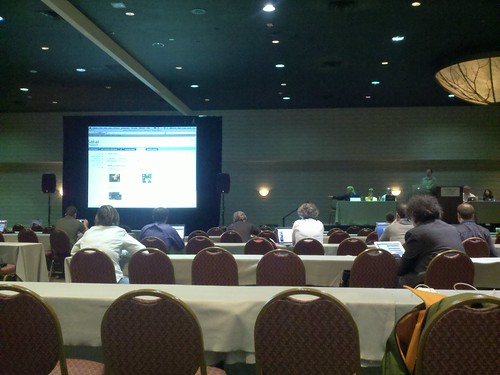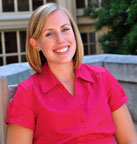This article is more than 5 years old.
June 14 – 16 I attended the Sakai Conference 2011 in Los Angeles, California to represent ZSR Library among the contingent from Wake Forest. I was joined by Jolie Tingen and Steven Wicker of the Instructional Technology Group, and Drew Ray, the Applications Administrator in IS responsible for Sakai.
Sakai is an open source platform used internationally. At the conference I was able to connect with users from Australia and the UK, for instance. At Wake Forest, Sakai serves as a space for teaching, learning, and collaborating. Many professors here use Sakai to manage their courses electronically. I appreciated the opportunity to represent ZSR Library, and specifically focus on ways we could integrate video and other library resources into Sakai.
While there was not an official conference theme, Katzou Yana, a Professor at Hosei University in Japan, set the tone for the conference during the keynote address. His message is that with Sakai, we can all do something better. Yana spoke of the Japanese Sakai community, which pushed forward with the country’s annual conference this past March, despite the earthquake. Three universities there use Sakai, and students receive lifetime accounts. The keynote opened my eyes to the people within the Sakai community who are passionate about their work with developing, using, and implementing this tool.
Overall, the conference taught me a considerable amount. I am happy to talk with anyone interested in learning more about topics covered at the conference. But, here I will share my Sakai top three:
Mid-morning on Tuesday, I attended “Distance Education 101: Preparing students for online learning,” facilitated by three faculty and staff members at the College of the Redwoods. After serving on ZSR Library’s DE committee, which focused on readying our library, I was interested in seeing how this school prepares its students. They discussed technical support, faculty support, and student support. The most intriguing part was the way they had developed a student orientation for those beginning online coursework. It is a two week free orientation offered each month, not only in the beginning of a semester. It covers many topics, one of which is “netiquette.” This includes how to write online in a formal manner, such as sending emails to professors and properly interacting in an academic discussion thread. (In other words, helping students avoid writing bonafide text messages to their professors and peers.) The orientation also includes computer readiness, and a host of other topics. It you’d like to know more, I’d be happy to share my session notes on this topic.
At Wednesday evening’s Tech Demo Showcase, I conversed with Susan Hollar at the University of Michigan. Michigan has developed a way to automatically integrate LibGuides into faculty’s Sakai sites. In short, a faculty member opts to turn on this feature within Sakai, the Sakai checks the available LibGuides for subject matches, and then integrates them into that Sakai course space. This code is not yet available in confluence, though. But hopefully it will be soon! I think a lot of faculty at Wake would appreciate this feature. 
Thursday morning I attended a session on Citations Helper, facilitated by Jon Dunn of Indiana University. This was a “Birds of a Feather” session, which meant the time was for discussion amongst those in attendance. Participants were mainly from the library-side of things, but there were others who worked in roles focused on instructional technology. The Citations Helper is in confluence, but very buggy. The session’s outcome was that some institutions volunteered time and people to test the code for specific bugs, and develop the solution. Most of the institutions who volunteered said they had computer science students who would enjoy the exercise of fixing real code. I am interested to see if and what will come of this. It was a great session to end on because I think this is what open source is all about–coming together to develop and improve the platform.
As I said above, those are my “Sakai Top Three.” Sakai 2011 was a great experience because it allowed me to better connect with colleagues at Wake and around the country, as well learn more about the world of open source platforms.
And finally, the obligatory tourist shot from Hollywood Boulevard: 
Fun fact: Did you know celebrities pay to have their star(s) on the Walk of Fame? After being nominated by a fan club, and approved by the Chamber of Commerce Walk of Fame Committee, they pay $25,000 grand for the star. And some headliners have more than one, because the stars are divided into different categories for TV, radio, movies, and so forth. Only in Hollywood!


1 Comment on ‘Gretchen at Sakai 2011’
I especially liked reading about the LibGuide/Sakai integration. Fascinating report-thanks!